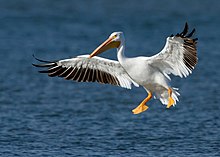American white pelican
| American white pelican | |
|---|---|
 |
|
| Flying in Dallas, USA | |
| Scientific classification | |
| Kingdom: | Animalia |
| Phylum: | Chordata |
| Class: | Aves |
| Subclass: | Neornithes |
| Infraclass: | Neognathae |
| Superorder: | Neoaves |
| Order: | Pelecaniformes |
| Family: | Pelecanidae |
| Genus: | Pelecanus |
| Subgenus: | Pelecanus |
| Species: | P. erythrorhynchos |
| Binomial name | |
|
Pelecanus erythrorhynchos Gmelin, 1789 |
|
| Synonyms | |
|
Pelecanus erythrorhynchus (lapsus) |
|
Pelecanus erythrorhynchus (lapsus)
The American white pelican (Pelecanus erythrorhynchos) is a large aquatic soaring bird from the order Pelecaniformes. It breeds in interior North America, moving south and to the coasts, as far as Central America and South America, in winter.
The German naturalist Johann Friedrich Gmelin described the American white pelican in 1789. The scientific name means "red-billed pelican", from the Latin term for a pelican, Pelecanus, and erythrorhynchos, derived from the Ancient Greek words erythros (, "red") + rhynchos (, "bill").
The American white pelican rivals the trumpeter swan, with a similar overall length, as the longest bird native to North America. Both very large and plump, it has an overall length of about 50–70 in (130–180 cm), courtesy of the huge beak which measures 11.3–15.2 in (290–390 mm) in males and 10.3–14.2 in (260–360 mm) in females. It has a wingspan of about 95–120 in (240–300 cm). The species also has the second largest average wingspan of any North American bird, after the California condor. This large wingspan allows the bird to easily use soaring flight for migration. Body weight can range between 7.7 and 30 lb (3.5 and 13.6 kg), although typically these birds average between 11 and 20 lb (5.0 and 9.1 kg). One mean body mass of 15.4 lb (7.0 kg) was reported. Another study found mean weights to be somewhat lower than expected, with eleven males averaging 13.97 lb (6.34 kg) and six females averaging 10.95 lb (4.97 kg). Among standard measurements, the wing chord measures 20–26.7 in (51–68 cm) and the tarsus measures 3.9–5.4 in (9.9–13.7 cm) long. The plumage is almost entirely bright white, except the black primary and secondary remiges, which are hardly visible except in flight. From early spring until after breeding has finished in mid-late summer, the breast feathers have a yellowish hue. After moulting into the eclipse plumage, the upper head often has a grey hue, as blackish feathers grow between the small wispy white crest.
...
Wikipedia

